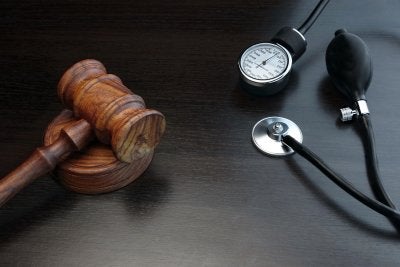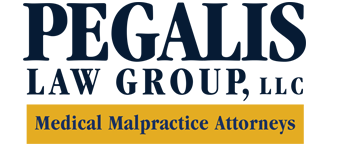-
Understanding Lawsuit Time Limits

If you have been harmed by substandard care that was provided to you by a medical professional, you may be wondering how long you have to file a lawsuit. The statute of limitations for medical malpractice cases differs from state to state. In the state of New York, generally, a medical malpractice claim must be filed within two and a half years from the time that the negligent action took place. However, there are many variables as to what the actual time limit is based on the types of health care providers. It is often confusing for the layperson. To be safe, speak with an experienced medical malpractice attorney as soon as you suspect medical negligence may have occurred.
If you are concerned about a misdiagnosis or possible medical error, contact the law firm of Pegalis & Erickson LLC in New York. For 46 years, we have advocated for people of all ages, in order to help our clients financially and make healthcare safer for everyone. You can reach us today by calling (516) 684-2900.
Attorney Advertising
-
How Long Do You Have to File a Medical Malpractice Lawsuit?
If you are considering filing a medical malpractice suit, one of the first things you’ll need to know is how long you have to do it. The time for bringing a lawsuit is called the statute of limitations. If the statute of limitations expires, you cannot file a lawsuit. The rules governing when you can file a medical malpractice suit differ from state to state. In New York, there are different time limits to file a lawsuit based upon the entity, whether the injured party is a minor or an adult, and also whether the person is alive or deceased. Time limits in which to bring a lawsuit are often complicated. To ensure that you don’t miss the deadline, talk to an experienced medical malpractice attorney as soon as possible after you suspect that you have been treated negligently.
 If you are concerned about a misdiagnosis or possible medical error, contact the law firm of Pegalis & Erickson, LLC, in New York. For 45 years, we have advocated for people of all ages, in order to help our clients financially and make healthcare safer for everyone. You can reach us today by calling (516) 684-2900.
If you are concerned about a misdiagnosis or possible medical error, contact the law firm of Pegalis & Erickson, LLC, in New York. For 45 years, we have advocated for people of all ages, in order to help our clients financially and make healthcare safer for everyone. You can reach us today by calling (516) 684-2900. Attorney Advertising
-
FAQs About Documenting Medical Malpractice
As a patient, you may be wondering if there is anything you can do to help ensure that your diagnoses are accurate. In fact, there are several steps you can take to fully document the treatment you are receiving and ensure that you have information that you can refer back to later. Here are the answers to some questions you might have:
 How many of my medical records should I keep? The simplest answer is “All of them.” If you are being treated for an ongoing health issue, you should keep any and all documents you receive from any medical professionals who treat you, along with other records of your interaction such as receipts. It’s generally advised that you hold on to medical records for at least 10 years.
How many of my medical records should I keep? The simplest answer is “All of them.” If you are being treated for an ongoing health issue, you should keep any and all documents you receive from any medical professionals who treat you, along with other records of your interaction such as receipts. It’s generally advised that you hold on to medical records for at least 10 years. How can I keep track of my treatment? One of the best ways to ensure that you have a comprehensive record of the state of your health as well as your medical treatment is to keep a health journal. In the journal, make a note of every appointment you have and write down as much as you can remember after each visit, particularly any instructions you get from your practitioner and any information about possible outcomes.
How can I tell if my diagnosis is correct? There are a number of strategies you can adopt in order to increase the likelihood of an accurate diagnosis. Bring a friend or a loved one with you during your appointment for support and to remind you of any questions you want to ask. If the practitioner who diagnoses you seems vague or unclear, get a second opinion. Having a clear record of your treatment and symptom history can also be useful to refresh your memory when you’re talking with your healthcare provider.
Are you in need of a medical malpractice attorney in Long Island, New York? Pegalis & Erickson, LLC is committed to providing patients and their families with the capable legal services they deserve. If you believe that you or a loved one has been affected by medical malpractice, please contact us today at (516) 684-2900 for a free consultation.
-
What Is the Time Limit for Filing a Medical Malpractice Claim?
In the legal field, time limits on filing medical malpractice claims are known as statutes of limitations. State law establishes the deadlines for particular types of claims filed within that state. In New York, patients effected by medical malpractice have just two and a half years to file a claim. There are limited exceptions to this rule and in regards to the specific type of medical malpractice. There are also shorter statutes of limitations when the malpractice occurs in New York State owned and operated hospitals or a hospital owned and operated by a municipality. Whether the injured party is an adult or a child, alive or deceased, all impact the time to file a law suit.
 Get in touch with a malpractice law firm in New York as soon as possible after realizingyou may have been subjected to medical negligence, such as emergency room errors, or misdiagnosis,. You can call the dedicated team at Pegalis & Erickson, LLC at (516) 684-2900.
Get in touch with a malpractice law firm in New York as soon as possible after realizingyou may have been subjected to medical negligence, such as emergency room errors, or misdiagnosis,. You can call the dedicated team at Pegalis & Erickson, LLC at (516) 684-2900. -
Spotlight on Common Medical Negligence Risks in 2017
Medication errors, birth injuries, and delayed diagnoses are all common types of medical malpractice that probably won’t ever be eliminated entirely. Improvements in hospital protocols and medical technology can help manage some of the risks. But unfortunately, advanced technology also opens the door to new types of medical negligence. Here are some of the top risks to watch out for during 2017.
Electronic Heal th Records (EHRs)

The days of paper patient charts are officially over. These days, doctors are more likely to consult a laptop or iPad in the exam room. Electronic health records (EHRs) document, manage, and share patient information in real time with other authorized users. This means that a patient’s lab results can be made instantly available to his or her primary care physician. When used properly, EHRs can be highly effective in coordinating a patient’s care. Unfortunately, not all doctors are adapting well to the digital age. If a healthcare provider has access to a patient’s EHR, but fails to refer to the vital information included in it, it’s possible to make a crucial error. For instance, the doctor might prescribe a medication a patient is allergic to or which is incompatible with other medications the patient is taking.
Patient Identification
Despite technological advances, errors in patient identification are still among the most common types of hospital negligence. When the wrong information is attached to the wrong patient record, it’s possible for doctors to administer incorrect treatment or even to perform the wrong sort of surgery. Hospitals have a responsibility to take reasonable preventive measures, such as by implementing strict registration desk protocols. Hospitals are also responsible for verification of patient’s identity wrist bands prior to administration of medications.Here at Pegalis & Erickson, LLC, we understand the confusion and mixed feelings that can follow an act of medical malpractice in New York. Our professionals can help you understand the issues involved with your case, and sort through your options for legal recourse. Call us at (516) 684-2900.
-
A Look at New York’s Medical Malpractice Laws
Medical malpractice laws are complex, and they vary from state to state. If you believe you could have a claim, it is important to contact a medical malpractice lawyer with experience practicing in New York. Here is a closer look at some of the specifics of medical malpractice laws in New York.
 Statute of Limitations
Statute of Limitations
The time to bring a lawsuit in New York for medical malpractice can be confusing for patients. If you suspect medical negligence occurred, do not delay in consulting an attorney so that your rights can be protected. The attorneys for the patient need to identify the health care providers who made the avoidable medical mistakes, in order to file the lawsuit.The time limits for filing a lawsuit, called statutes of limitations, are laws which dictate when a lawsuit must be started. Whether the patient is an adult or child, and is alive or has died, all play a key role. In New York the entity involved– such as private facilities, city, state or federal facilities- all have a different time requirement for filing a lawsuit. Once the time limit has expired, a law suit cannot be brought, so if negligence is suspected, action must be taken quickly.
Medical Malpractice attorneys along with medical experts will determine if something serious happened with the medical care you or your loved one received, that should not have occurred. They will gather and review medical records and information, to identify avoidable medical errors.
You can trust the experienced team at Pegalis & Erickson, LLC to help you protect your rights if medical malpractice in New York has happened to you. Talk to an attorney today by calling (516) 684-2900.
-
Your Legal Rights After a Health Crisis
When someone experiences a health crisis or medical injury, they often do not consider the possibility of medical malpractice at the time. No one wants to imagine the worst case scenario when you or loved one experiences an unanticipated outcome after a medical treatment, but it is important to know that time is of the essence. The problem is that if you suffer a life-altering health injury as a result of medical errors, there is a limited time to recover for the financial burdens, and physical pain and suffering you are experiencing. As months pass, the statute of limitations– that is, the period of time one has to file a claim to prove that medical negligence occurred—may run out, and families are left in difficult, and permanent debilitating situations, without being able to pursue justice and seek appropriate compensation. The time limits for filing a claim—statutes of limitations—are decided by each state and vary greatly by incident.

In New York, there are different time limits for when a lawsuit must be filed, based upon the type of health problem, and the entity that caused the avoidable medical error. And, lawsuit time limits are different on if the patient died or is living, and what type of health care provider it was: an individual, a government employee, a private hospital, a municipal hospital, or a state-run facility. It is important to know that once the statute of limitations has expired, no matter how serious the medical injury, a lawsuit cannot be brought. Experienced medical negligence New York-based attorneys can consult with you on your particular situation to access and research if your injury occurred within the state time limit, and if medical treatment truly did not follow the standard of care that the medical profession has set.
It is important to consult legal counsel as soon as possible so that your rights are protected.
At Pegalis & Erickson, we focus on helping those who experience medical errors to investigate if seeking compensation is possible. Please give us a call at (516) 684-2900 or visit our website to learn how we can help.
-
What Are the Factors Involved in Proving Misdiagnosis Malpractice?
 Misdiagnosis is a type of medical malpractice that occurs when a physician’s negligence leads to an incorrect diagnosis or delayed diagnosis that causes harm to the patient. It is important to note that misdiagnosis malpractice involves more than simply incorrectly diagnosing or delaying the diagnosis of a condition. To demonstrate malpractice, your attorney must prove medical negligence has occurred.
Misdiagnosis is a type of medical malpractice that occurs when a physician’s negligence leads to an incorrect diagnosis or delayed diagnosis that causes harm to the patient. It is important to note that misdiagnosis malpractice involves more than simply incorrectly diagnosing or delaying the diagnosis of a condition. To demonstrate malpractice, your attorney must prove medical negligence has occurred. There are three main factors in proving misdiagnosis medical malpractice. The first is to prove that a doctor-patient relationship actually existed. The second is proving that the doctor was negligent in the misdiagnosis because he or she did not provide reasonable and competent care. Lastly, your medical malpractice lawyer must show that this negligence caused harm. Errors can occur even when doctors provide reasonable and competent care, so demonstrating that the care provided was not competent is a crucial part of the case.
Does your misdiagnosis meet the criteria for medical malpractice? Call Pegalis & Erickson, LLC at (516) 684-2900 to discuss your case with a medical negligence lawyer serving Long Island and determine if you are eligible to seek compensation.
-
What Is Your Right to Know the Facts After a Medical Mistake?
 A medical mistake can have tragic consequences, including birth injuries that can result in permanent disability. But far too often, parents are told that birth injuries or maternal injuries were inevitable; that there was simply nothing the doctors could have done. If you, your partner, or your child may have been affected by medical malpractice, you do have the right to know what happened.
A medical mistake can have tragic consequences, including birth injuries that can result in permanent disability. But far too often, parents are told that birth injuries or maternal injuries were inevitable; that there was simply nothing the doctors could have done. If you, your partner, or your child may have been affected by medical malpractice, you do have the right to know what happened. The hospital staff won’t always be forthcoming with the facts, which is why families might turn to a medical negligence lawyer for help. A lawyer can request medical records and review the case, perhaps with the help of a medical consultant. A lawyer can also help families affected by medical mistakes seek compensation for their loved ones’ injuries.
At Pegalis & Erickson, LLC, we have devoted our lives to defending the legal rights of families who have been affected by medical malpractice in Long Island, New York and beyond. We firmly believe that families have the right to know what has happened when a loved one is affected by medical negligence. If you’re looking for answers about possible medical malpractice, call us today at (516) 684-2900.
-
When Are Hospital Staff Supposed to Wash Their Hands?
 Hospital-acquired infections are a common cause of compromised health, hospital re-admittance, and even death. These complications may sometimes be said to constitute medical malpractice and may lead to a wrongful death lawsuit. Yet, the most basic of hygiene activities can significantly curb the spread of infections in healthcare facilities. By simply washing their hands at the necessary times, healthcare providers and hospital technicians can help protect their patients.
Hospital-acquired infections are a common cause of compromised health, hospital re-admittance, and even death. These complications may sometimes be said to constitute medical malpractice and may lead to a wrongful death lawsuit. Yet, the most basic of hygiene activities can significantly curb the spread of infections in healthcare facilities. By simply washing their hands at the necessary times, healthcare providers and hospital technicians can help protect their patients. Handwashing and antiseptic use is necessary when hospital staff is in high-risk areas or handling high-risk patients. High-risk areas include burn units, trauma care centers, and oncology units. Healthcare providers are expected to thoroughly cleanse the hands before and after touching wounds, before initiating invasive procedures, after caring for an infectious patient, and after touching any object that may be contaminated.
Patients who may have been wronged by acts of medical malpractice are invited to call Pegalis & Erickson, LLC at (516) 684-2900. We are a medical malpractice firm located in Long Island, New York.
Recent Posts
Popular Posts
categories
- Uncategorized
- Infographic
- Patient Safety
- Patient Health
- Stillbirth
- Birth Injuries
- Medical Malpractice
- Medical Negligence
- Event
- Erb's Palsy
- Injury
- ER
- Video
- Cancer Misdiagnosis
- Medication Errors
- Cerebral Palsy
- Medical Negligence Lawyer
- Anesthesia Injuries
- Brachial Plexus
- Prostate Cancer
- About Us
- Men's Health
- Skin Cancer
- Breast Cancer
- Misdiagnosis
